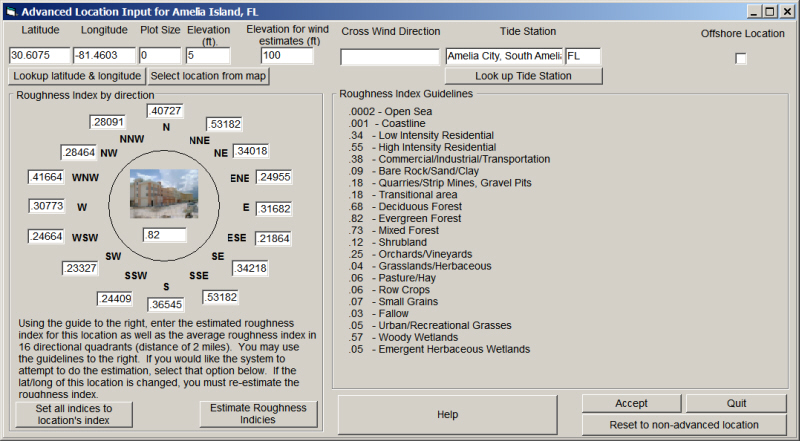
Advanced Wind Estimation Data Entry
Data entry on this form should be considered with extreme care as it can result in lowering the estimated wind speeds significantly for this location on all reports.
The following is the “default” / new AWE data entry form. Generally you will not change the roughness index values on this form unless you have good knowledge of the locations environment. Changing the roughness index value will have a significant affect on calculated wind speeds.

This option allows the user to enter "advanced" information about locations. Locations can be anything that have latitude and longitude and size attributes. I.E. A city, island, point, lighthouse, etc.. Remember western longitudes are negative while eastern longitudes are positive.
Location Name - This identifies the location's name
State - This identifies the location's state or country code (2 or 3 digits)
Latitude - This identifies the location's latitude in decimal degrees. All latitudes north of the equator are positive and those south are negative. Latitudes for the North Atlantic and Eastern Pacific are positive. NOTE: DO NOT USE DEGREES AND MINUTES. To convert degrees/minutes to degrees and tenths of a degree, take the number of minutes, divide by 60 and add it to the degree value. I.E. 29 degrees 36 minutes is 29.6 degrees.
Longitude - This identifies the location's longitude in decimal degrees. All Western longitudes are negative while all Eastern longitudes are positive. Longitude values for the Atlantic and Eastern Pacific locations are negative. NOTE: DO NOT USE DEGREES AND MINUTES. To convert degrees/minutes to degrees and tenths of a degree, take the number of minutes, divide by 60 and add it to the degree value. I.E. -78 degrees 54 minutes is -78.9 degrees.
Plot Size - This represents the circular size of this location. This can range anywhere from 0 to 100 nautical miles. A zero value will not draw any circle, thus being well suited for geographical landmarks like points, bays, etc.. Other values will draw circles or points depending on the size of the location and size of the map they are plotted on.
Location Elevation – This indicates the location’s elevation above mean sea level in feet. It is only used by the SLOSH report function and supersedes the elevation calculated by the DEM (digital elevation model) data included with the system.
Elevation for wind estimates – This indicates the elevation, above ground level, that the wind estimation calculations should be made for. The standard level is 10 meters (33 feet) but you can define elevations (feet) up to 1000 feet. This is particularly useful when needing to know the wind speed forecast for high rises, bridges and other assets higher than 33 feet. For more information about this function, see the appendix section.
Cross Wind/Flood Direction - This identifies either the direction of the cross wind across a runway (for example) or if used in the flood index for a location, the direction that flooding typically occurs from. For information on how this is used in runway crosswind analysis, see Cross Wind calculation setup and use. In the example for storm surge flooding... in Miami a direct East wind (090 degrees) is the direction that flooding occurs. In Panama City, FL, the direction is more like SSW or 200 degrees. This is used in the detail location reports when calculating onshore wind flow and also the location report flood index graph.
Tide Station - This identifies the tide station associated with this location. To associate a location to a tide station, click on the "Look up Tide Station" option. The user will then be presented with a tide station selection window.
Offshore Location - This identifies the location as a fixed offshore location, such as an oil platform, etc.. When checked the system will include wave height calculations in the summary and detailed impact report for this location
Roughness Index (by direction) - This is an important data element. It describes the exposures that are characteristic for this location. For each of the 16 compass directions the average roughness index for 2 NM in this direction is shown. These values have been pre-calculated for the default locations. If you add a new location and do not choose the "Estimate Roughness Index" option, the system will prompt the user to automatically calculate the roughness indices upon exit of this screen. If you update a location's position (Lat, Long), the user should select the "estimate roughness indices" option. These value has a significant impact on the wind speeds estimated by Advanced Wind Estimation.
The options available from here are:
To
lookup a location's
latitude and longitude,
select the Lookup
Latitude and Longitude option.
To associate a
location to a tide station,
select the "Look
up Tide Station" option.
To accept the changes, selection the "Accept" option.
To reject all changes, select the "Quit" option.
To clear all advanced location data for this location, select the "Reset to non-advanced location", option. This will clear all roughness index information for this location. This is not suggested.